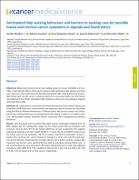| dc.contributor.author | Moodley, Jennifer | |
| dc.contributor.author | Constant, Deborah | |
| dc.contributor.author | Mwaka, Amos Deogratius | |
| dc.contributor.author | Scott, Emilie Suzanne | |
| dc.contributor.author | Walter, Mary Fiona | |
| dc.date.accessioned | 2021-04-29T09:13:48Z | |
| dc.date.available | 2021-04-29T09:13:48Z | |
| dc.date.issued | 2021-01-14 | |
| dc.identifier.citation | Moodley, J., Constant, D., Mwaka, A.D., Scott, S.E. and Walter, F.M., 2021. Anticipated help seeking behaviour and barriers to seeking care for possible breast and cervical cancer symptoms in Uganda and South Africa. ecancermedicalscience, 15. | en_US |
| dc.identifier.issn | 1754-6605 | |
| dc.identifier.uri | http://hdl.handle.net/20.500.12280/2789 | |
| dc.description.abstract | Objectives: Breast and cervical cancers are leading causes of cancer morbidity and mortality in sub-Saharan Africa. Most women present with advanced-stage disease and have poor outcomes. This study aimed to describe anticipated help-seeking behaviour for possible breast and cervical cancer symptoms, barriers to accessing health care and factors associated with less timely anticipated help-seeking in urban and rural settings in Uganda and South Africa (SA).
Methods: We conducted a cross-sectional community-based survey between August and December 2018. Data were collected from one randomly selected woman per household using the African Women Awareness of Cancer breast and cervical cancer tool. Anticipated help-seeking behaviour was dichotomised into waiting <1week or ≥1 week to seek care. Multivariable analysis identified factors associated with anticipated help-seeking behaviour.
Results: One thousand, seven hundred fifty-eight women participated (Uganda 873, SA 885, median age 34, interquartile ranges 26–47). Most would discuss symptoms with someone close to them (87.7% for breast, 83.0% for cervical symptoms). The majority anticipated seeking care from a health facility in <1 week: 86.1% and 88.0%, respectively, for breast and cervical symptoms. 38.7% of women expected to encounter at least 1 barrier when seeking care. Lack of money for transport or clinic costs was the most common barrier (24.6% of participants). For both cancers and in both countries, women who reported more barriers were significantly less likely to anticipate seeking timely care. In SA, rural location was also associated with longer anticipated time to seek care, adjusted prevalence ratio (aPR) 2.92, 95% confidence interval (CI) 1.48–5.76 and aPR 2.42, 95%
CI 1.08–5.45 for breast and cervical cancer, respectively.
Conclusion: Interventions that improve community level cancer knowledge and highlight the importance of prompt help-seeking for possible symptoms are important to promote timely care seeking. In addition, addressing financial barriers by reducing transport and clinic costs and tackling geographical inequities in access to care could support women in seeking timely care for possible symptoms. | en_US |
| dc.language.iso | en | en_US |
| dc.publisher | National Center for Biotechnology Information (NCBI) | en_US |
| dc.relation.ispartofseries | ecancermedicalscience;15 | |
| dc.subject | Help-seeking | en_US |
| dc.subject | Breast cancer | en_US |
| dc.subject | Cervical cancer | en_US |
| dc.subject | Barriers to care | en_US |
| dc.subject | Symptoms | en_US |
| dc.title | Anticipated Help Seeking Behaviour and Barriers to Seeking Care for Possible Breast and Cervical Cancer Symptoms in Uganda and South Africa | en_US |
| dc.type | Article | en_US |


